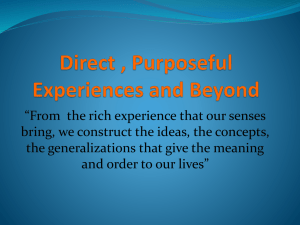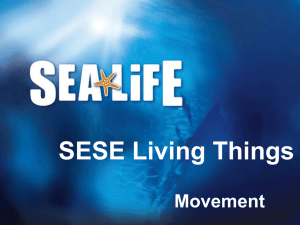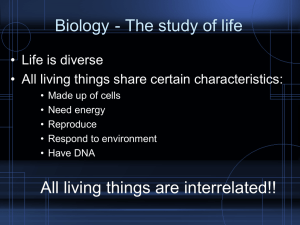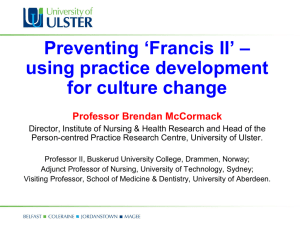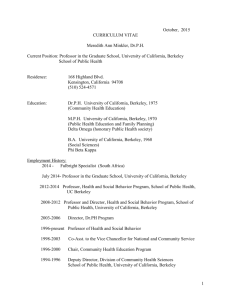here - Putting You First
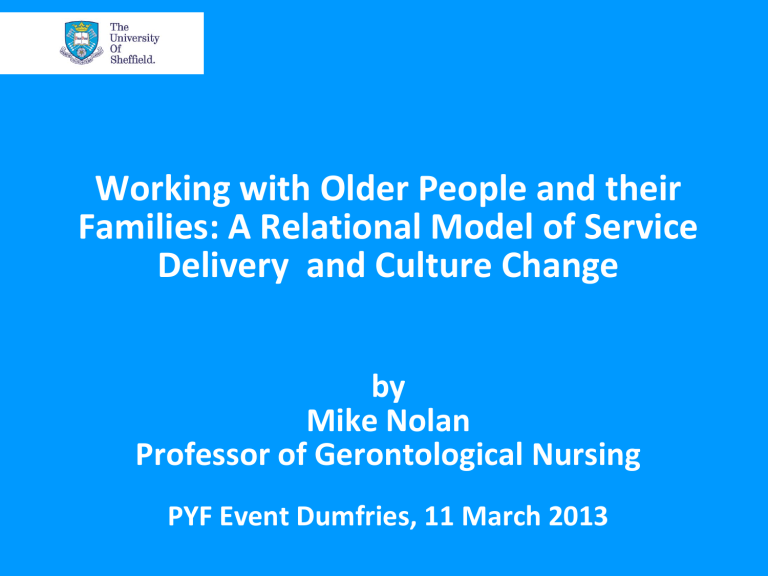
Working with Older People and their
Families: A Relational Model of Service
Delivery and Culture Change
by
Mike Nolan
Professor of Gerontological Nursing
PYF Event Dumfries, 11 March 2013
You can’t discuss something with someone whose arguments are too narrow
Person-centred care – mantra of the decade
• Care that is based around an individual and their needs
(DoH 2001)
• Assessment is a person-centred activity with an emphasis on establishing areas of need to maintain or increase independence and quality of life
(McCormack and Ford 2000)
• Key values underpinning the ‘single assessment process’ are person-centred care and independence
(Norman 2005
The roots of ‘person-centred’ care
• Pioneering work of Tom Kitwood, Bradford Dementia
Group – Dawn Brooker
• See the person not the disease
• Creating a positive environment of care
• Original vision not consistent with current usage
• Little more than a political slogan
(Burstow 2006)
Time to question our values
• Independence, well-being and choice
• ‘Cultural glue’
• Consistent with other concepts in academic and policy literatures
• Successful ageing
• Autonomy and independence
• What of interdependence?
• Are current values appropriate?
Successful ageing: What’s not to like?
How is success defined?
• Three requirements for successful ageing
- Avoidance of disease and disability
- High levels of physical and cognitive functioning
- Active engagement with life (Holstein and Minkler 2003)
• Use of term successful itself is problematic as, by definition, it casts those who do not ‘measure up’ into the alternative ‘unsuccessful’ category
• Constitutes the ‘new ageism’ (Holstein and Minkler 2003) based on a vision of the ‘super-aged’ (Feldman 1999)
What of autonomy and independence?
• Beware the ‘new gerontology’ with its focus on
‘individually successful ageing’ that results in an impoverished view of what a good old age can be’
(Holstein and Minkler 2003)
• Autonomy and individuality are ‘incapable of underpinning any shared societal responsibility for the health of all its members, including the least advantaged’ (Evans 1999)
• Need a relational view of autonomy that recognises that people are never fully independent
(MacDonald 2002)
Care of older people: W(h)ither now?
Developing The Senses Framework
• Evolved over a 25 year period
• Intellectual itch
- What provides a sense of therapeutic direction for staff in LTC environments?
• Cure
• Rehabilitation
• ‘Good geriatric care’ (Reed and Bond 1991) or ‘Endless residual care’ (Evers 1981)
Creating an ‘enriched environment’
• Security – to feel safe physically, psychologically, existentially
• Belonging - to feel part of a valued group, to maintain or form important relationships
• Continuity - to be able to make links between the past, present and future
• Purpose - to enjoy meaningful activity, to have valued goals
• Achievement - to reach valued goals to satisfaction of self and/or others
• Significance - to feel that you ‘matter’ and are accorded value and status
Creating the right environment for others to grow?
• Not just ‘others’ but everyone
‘If employees are abandoned and abused , probably clients will be too. If employees are supported and encouraged they will take their sense of well-being into their day-to-day work’.
(Kitwood 1997)
An enriched environment for all
Older people
Family carers
Staff Students
Security
Belonging
Continuity
Purpose
Achievement
Significance
Models of culture
• Perform or Perish
-Pace: quick fix, short term, process driven
-External, top down agenda
-Select few determine direction
-Punitive mandatory way of working
-Metrics matter: superficial quantiative targets for success
-Scored
-Impoverished environment ‘senses reduced’
• Relational and Responsive
-Complexity – longer term, evolving focus on people and perceptions
-Locally contextual
Highly inclusive of all groups
Empowering, inspiring, transformational way of working
Meaning matters, relational, dynamic qualitative ‘indicators’ of success
-Profiled
Enriched environment ‘senses enhanced’
Looking to the literature
• Highly complex ‘slippery’ concept
• Multifaceted (Stone 2003)
• Service culture-goals of care
• Caring culture – quality of relationships
• Work culture – staff nurtured and supported
• Local culture – culture of the office (Twigg and Atkin 1994)
• Complex social interactions (Powell et al 2009)
Reconfiguring the senses
Significance
Purpose
Achievement
Define our direction of travel
Culture of care
Security
Belonging
Continuity
Define the conditions needed to arrive
Climate of care
Using the ‘Senses’ and related Frameworks
•
The 4 ‘P’s’ shape the environment of care
•Place: what is the nature of the environment?
•People: Who are they, what skills, abilities and needs do they have?
•Processes: How are things done around here?
(RCN 2008, NCM 2009)
•Perceptions: How do people think and feel about what they do and where they work?
(Patterson et al 2011)
The ‘Place’
• Key leadership behaviours
• Do you:
• Instil a sense of pride by focusing on what is done well?
• Inspire confidence by saying positive things?
• Consider everyone’s opinion when making decisions?
• Consult colleagues about daily issues?
• Act in a caring and supportive manner towards colleagues?
• Set clear and explicit expectations?
• Establish strong standards of excellence in care?
• Have a “presence” – make yourself readily available?
• Actively coach colleagues to help them improve their care delivery?
• Lead by example?
Key aspects of an ‘enriched environment’
Sharing a Philosophy of Care
Where you work do you:
• Share an explicit philosophy of care?
• Value the psychological aspects of care?
• Communicate your philosophy and values to new members of staff?
• See involving users and carers as essential?
• Have a culture that is about caring for people and supporting them rather than ‘achieving targets ’?
Supporting Each Other
Where you work:
• Do colleagues show concern and support each other to deal with stresses at work?
• Do colleagues provide each other with emotional support?
• Are the emotional demands of care-giving acknowledged and addressed?
• Do colleagues feel confident about the competence and abilities of other team members?
• Is there a great deal of trust among members of the team?
• Can team members really count on each others’ help with any difficulties?
Feeling Safe
Where you work:
• Do people feel safe to be themselves and express their views without fear of criticism, censure or feeling foolish?
• Do people feel safe to bring up problems and tough issues?
• Do people feel safe to challenge poor practice without fear of being rejected?
• Are differences of opinion between staff well handled?
Improving Practice
Where you work:
• Do the team discuss performance objectives?
• Do the team discuss ways of making your vision a reality?
• Do the team make the time to share relevant information?
• Do the team discuss how to improve things when mistakes or errors happen?
• Do team members take time to reflect on their performance?
• Do the team regularly take time to figure out ways to improve care delivery?
Having a Say
Where you work:
• Can team members influence what goes on ?
• Can team members have a say in how work is managed?
• Can team members participate in all decisions that affect them?
• Do team members have the freedom to make important work decisions?
• Can team members determine how work is done?
• Can team members carry out their work in the way they think is best?
Developing our Skills
Where you work:
• Are staff given time and opportunity to develop new work skills?
• Is training and professional development readily available for everyone?
• Is staff development supported by mentoring and clinical supervision?
MDT Working
Where you work:
• Do staff work well with other members of the MDT?
• Is there good communication among members of the MDT?
Having Resources
Where you work:
• Is there sufficient basic equipment and supplies to deliver good level of care?
• Is there adequate support services to allow staff time with clients?
• Are there enough skilled staff to provide high quality care?
Too Much To Do
Where you work:
• Is there too much work to do in too little time?
• Are staff asked to do work without adequate resources to complete it?
• Can staff follow best practice in the time available?
• Do staff have to make trade-offs between the quality of work and cost savings?
Processes: ‘How are things done around here’?
Where you work what processes are in place for:
• Facilitating good communication (belonging/continuity)
• Allocating work (continuity)
• Agreeing goals and values (significance/purpose)
• Celebrating success (achievement/significance)
• Addressing difficult issues (security)
• Providing staff with emotional support (security)
• Indentifying individual goals and aspirations
(significance/purpose/achievement)
• Inducting new staff (all the senses)
• Ensuring everyone has a say (all the senses)
• Involving users and carers (all the senses)
